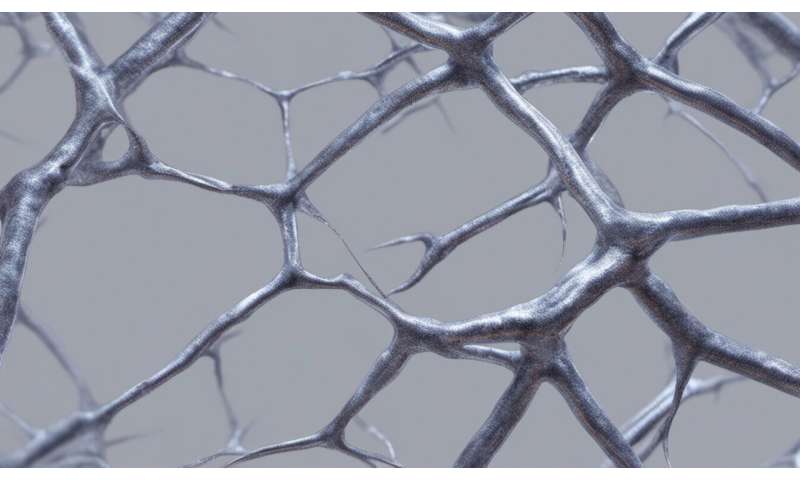
What happens when you bring three scientists of diverse disciplines together, and give them the resources of two of the country’s top research facilities? In this case, they discover a new material that may help scientists learn more about neurological disorders, and possibly take some big steps toward brain-machine interfaces.
This pivotal discovery, making use of two user facilities at the U.S. Department of Energy’s Argonne National Laboratory, was led by three scientists from Purdue University. Their fields of study are so disparate that without this project, they may never have collaborated. The results of their combined efforts—published in Applied Materials and Interfaces, a magazine of the American Chemical Society—could lead to breakthroughs in each of their disciplines.
The three Purdue scientists at the helm of this research team—Shriram Ramanathan, professor of materials engineering; Hyowon “Hugh” Lee, assistant professor of biomedical engineering; and Alexander Chubykin, assistant professor of biological sciences—were connected through a Purdue initiative to bring scientists working on disparate ideas together. Chubykin and Lee had been collaborating on new ways to sense neurotransmitters in the brain, seeking materials that could trace these chemicals with greater sensitivity and speed.
Unbeknownst to both of them, Ramanathan had been working on just such a material for years, discovering doping methods for perovskites, a semiconducting material also used in some other types of applications such as solar cells and light-emitting diodes (LEDs), to be more sensitive to certain chemicals. This material—a perovskite nickelate coated with a nafion layer—turned out to be just what his colleagues were seeking. Through a series of tests, the team discovered that this material is perfect for tracking glutamate, a chemical that the brain’s nerve cells use to communicate with other cells.
“Our skill sets are so different that collaboration was essential to take these types of materials into new areas,” said Ramanathan.
Glutamate, one of the most abundant amino acids in the body, is used by every major brain function and is one of the primary molecules the brain uses to send and receive information for control of motor function, learning and remembering. Tracking its presence or absence in certain areas of the brain could lead to more insight into autism and other disorders.
“Different forms of autism create different changes to glutamate levels in the brain, and understanding them is important,” said Chubykin. “Neural degeneration is marked by a decrease in glutamate. If we can measure that better, it will be very exciting.”
Several candidates for glutamate biosensors have been developed in the past, but this new material greatly improves both the sensitivity level and the response time. To understand the composition and structure of the new material, crystals of it were grown and analyzed at the Center for Nanoscale Materials (CNM), and X-ray analysis of the material was conducted at the Advanced Photon Source (APS). Both CNM and APS are U.S. Department of Energy (DOE) Office of Science User Facilities at Argonne.
Ilke Arslan, the director of CNM, is a co-author on the paper. She and her team were involved in characterizing the perovskite nickelate thin films of this material by imaging them at the atomic scale using CNM’s powerful electron microscopes.
“This interdisciplinary collaboration is a wonderful demonstration of how materials science and characterization at the atomic scale can link with biomedical engineering and neuroscience to lead to new breakthroughs that will benefit humankind,” Arslan said.
X-ray measurements were carried out on two APS beamlines: 33-ID-D and 29-ID-D, both operated by Argonne’s X-ray Science Division (XSD). The powerful X-rays of the APS allowed for precise imaging of the reactions within the material to the presence of various doses of glutamate.
Fanny Rodolakis, an XSD physicist, worked with the Purdue team at 29-ID-D. She said she has been working with Ramanathan for about a year, and is fascinated by the applications for the materials he brings to the APS.
“They know their samples very well and are able to fully characterize their macroscopic properties, but they don’t have the tools to look at them on a microscopic, quantum level,” Rodolakis said. “You need a light source like the APS, so you can tune the energy of the X-ray beams to see how the chemical treatments affect the material on this level. They have the perfect samples, and we have the perfect giant toolbox to help them.”
The glutamate-sensing properties of this material were tested in brain slices, but the most crucial test was with live mice—what scientists refer to as in vivo, or performed in a living organism.
“We need ways to understand the brain while it is alive, because our usual characterization involves looking at brain slices post-mortem,” Arslan said.
In Chubykin’s lab at Purdue, the new material was implanted into the visual cortex of a mouse under anesthesia, and when the mouse awoke, scientists were able to track its responses to visual stimuli.
“We showed the mouse pictures,” Lee explained. “We showed it a checkerboard pattern, lines and bars, images that the brain responds to most.”
The results showed increased sensitivity and faster response time than other glutamate-sensing materials. The next step, Ramanathan said, is to create smaller microneedles to track glutamate in specific sections of the brain, working with more specific stimuli. This, he said, opens up more possibilities to sense different types of neurotransmitters.
For Ramanathan, this material is also a step toward machines that can interface with the human brain and possibly read and react to sensory information. He calls this the holy grail of neural links.
With such promising results, this team intends to keep its association going.
Source: Read Full Article